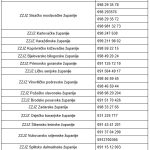Experts from the Croatian Institute of Public Health have created a working version of the strategy for the adaptation of coronavirus measures and divided it into three phases, Croatia is now slowly entering another phase.
As Poslovni Dnevnik writes on the 22nd of April, 2020, the Dnevnik Nova TV team learned the details of the strategy currently being proposed by epidemiologists.
In the first phase, which is now behind us, new cases were discovered, the number of tests was increasing, and protective equipment was being procured. Strict measures were also enacted: shops had their working hours cut short, some were closed, public transport was abolished, schools, kindergartens, colleges, and public events were all cancelled.
In order to get to the second phase, it will take a few days and Croatia will need to see a drop in new coronavirus cases. It is also important that hospitals don’t become overcrowded so that they’re ready and able to provide care to anyone in need of hospitalisation, and so that a large number of coronavirus tests can also be performed. More than 1500 blood samples have been being tested over recent days.
At this stage, children should gradually return to schools and kindergartens. That is where the physical distance should be ensured, the classrooms should be disinfected regularly, hands should continue being washed, and special attention should be paid to teachers and students who belong to at-risk groups or live with someone within that group. Those people would not initially attend classes.
At the beginning of this second phase, the ability to travel longer distances may be established, but keeping physical distance from other people must also be observed. This means, for example, that there may be a limited number of passengers on a bus at any one time.
Shops would open again, but certainly not all at once. Thus, their working hours would also be gradually extended, first to small shops. We will need to continue to wait in line to make purchases because the need to only allow a certain number of people inside stores will still be in place at this stage. Disinfectants upon entering stores will also still be available.
Of the other service activities, those that don’t require physical contact will be among the very first to re-open their doors, provided they can provide physical distance between users of the service.
Weddings and funerals will be able to take place. First they will be limited to 10 and then to 30 people. This number would gradually increase, but with the condition of keeping physical distance implied.
The police are still warning citizens who are outside in a group of more than five people to separate and leave, but this rule would then increase to 10 and subsequently to more people, provided that the number of people testing positive for coronavirus doesn’t start to increase rapidly again.
Children’s sports grounds and playgrounds would open when the schools are opened, but with rules on the maximum number of people who can recreate at the same time.
The third phase will see Croatia return to normal. Then, restrictions on social gatherings would be lifted, but distancing will remain a rule. Service activities involving physical contact will have further prescribed rules, and they will need to keep records of the parties they come into contact with so that they can be contacted if a coronavirus infection occurs.
In this third phase, we will gradually be able cross borders without any anti-epidemic restrictions, but it is possible that persons arriving to Croatia from countries where, for example, there are a larger number of coronavirus infected persons, will still have their entry restricted.
Unless you have to, it seems like travel won’t return to normal for a while, as experts continue to recommend that you avoid travel that isn’t necessary until the very end of the coronavirus epidemic. In this third phase, the faculties, ie higher education institutions, would open their doors completely, once it was proven that the opening of schools and kindergartens didn’t worsen the epidemiological situation.
The exact dates all this will happen, however, depend on what the epidemiological picture in Croatia will look like. This is a working version written by experts and will certainly have to be adjusted accordingly and as needed, writes Dnevnik.
Make sure to follow our dedicated section for all you need to know about coronavirus in Croatia.










